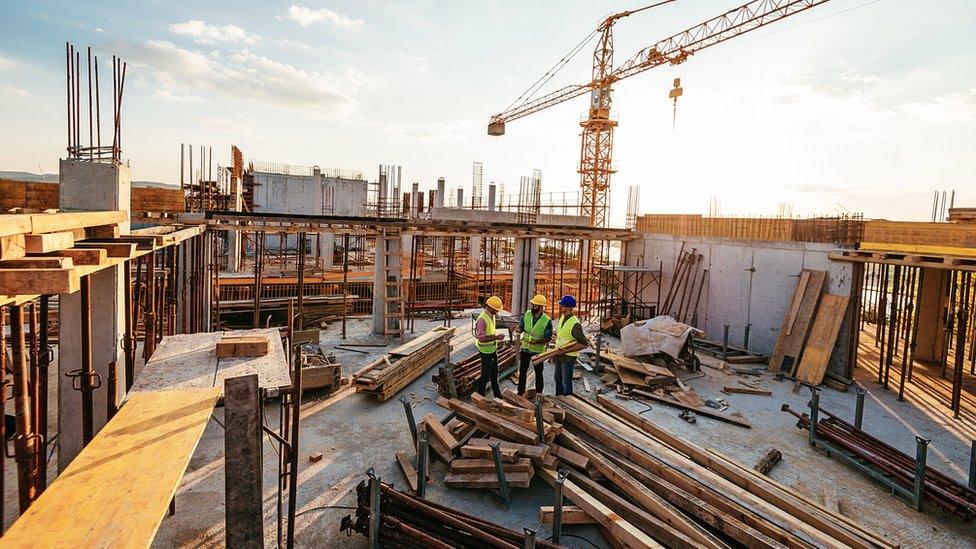In-migration and Output
- Published

Scotland's economic growth rate is not impressive, but it's keeping up with the Smiths next door, and ahead of the Joneses.
The population hardly grew for most of the past 50 years, except that it grew older. A new report finds that if immigration and population growth matched the rest of the UK, Scotland would have grown faster than everywhere except London.
Brexit may remove the appeal of Scotland for EU nationals, so attention could shift to attracting more, and more productive immigrants from south of the Border.
What if... ? It's one of those questions which both fascinate and irritate historians.
But economists at PwC aren't so easily annoyed. They've asked the question: what if Scotland had the same level of immigration and population growth over the past 50 years that the rest of the UK has seen?
The answer includes quite a lot of social and cultural change. But the economists are more interested in what they can see happening to growth.
Because immigrants are typically youngish, resourceful and hard-working, they have a habit of boosting the economic growth rate.
That is why the Scottish government is keen to get more of them, to stop the growth rate stalling.
Out of puff
The latest figures, covering the last quarter of 2018, are reassuringly ahead of the UK. That's a turnaround from a year ago, when the data told us Scotland faced a profound crisis of low growth.
Things changed, though not so much the economy as the data. As already noted, a major revision by statisticians in St Andrews House concluded that 2015 and 2016 were grimmer than they had thought, probably due to the oil and gas downturn, but that 2017 and 2018 weren't so bad as they had appeared.
However, at 0.3% for the October to December back quarter of 2018, compared with the UK's 0.2%, it's not quite the basis for national pride or celebration.

Over last year, the growth rate for Scotland and the UK as a whole was the same, with total output from the economy 1.4% higher at the end of 2018 than it was at the end of 2017. It's growth, but (as the didn't quite say in Star Trek) not as we need it.
The PwC bods have added to the general sense of gloom around the sluggish state of the economy, coming recently from the Bank of England and the Office for Budget Responsibility.
All the forecasts have taken below-trend growth forecasts for 2019, given them a Brexit squeeze, and then a tighter squeeze to account for a slowdown in export markets. While Brexit has pushed the UK from leading the G7 pack with its growth rate to being an outlying laggard, it is now closer to the middle of the pack, purely because other industrialised nations have run out of growth puff.
Hyped City Deals
The OBR cut its 2019 UK forecast for this year from 1.6% to 1.2%. And that's with an orderly, agreed Brexit, in line with the UK Government's stated policy. (They didn't give us alternative numbers for disorderly departure, but be assured that it would not look better.)
PwC's forecast comes in at 1.1% for the UK economy, and gives Scotland a slightly better outlook at 1.2% forecast. By next year, it reckons both will have reached 1.6%.
The reckoning is that there's still relatively more public and private investment going on. The much-hyped City Deals may be having an economic impact.

And as with the unemployment figures out this week, Scottish growth stands up well in the league table of UK nations and regions.
PwC forecasts less than 1% growth this year for Yorkshire and Humberside, the North-East, Wales and Northern Ireland.
Financial crash
So, you're asking (as if I'd forgotten), what's all this about immigration?
Well, this economists report, published on Thursday, reflects figures back to 1970, setting growth rates alongside immigration and population change.
This gives some historic context to the figures we're seeing at the tail end of dismal decade of slow growth and slower pay increases. The average in the 1970s was 2.3%, cut sharply to 1.5% in the 1980s, as heavy industries were closed, then up to 2.2% in the decades to the 2008 financial crash, since when the average has been 1.6%.

Now, try setting that against population, by calculating growth per capita. Total output from the economy between 1972 and 2010 was found to be 1.9% in the average year, while the population grew by an average of less than 0.1%.
In other words, the growth was taking place despite the absence of significant inward migration or population growth. And it put Scotland in sixth position among the 12 nations and regions of the UK (as used by the Office for National Statistics).
But if Scotland had had the same levels of immigration and population growth as the rest of the UK, PwC reports it could have been the second fastest growing part of the UK, behind London.
Over-heated London
It wasn't all down to low immigration. There were other demographic effects, from shorter lives, and an older population as younger people had a habit of leaving.
There have been efforts to retain more of Scotland's younger people in Scotland. The efforts to make Scotland an explicitly, enthusiastically welcoming place for immigrants began 15 years ago.
With the help of those open borders from new members of the European Union, Scotland's population decline was not only arrested but turned around.
But the flows of immigration have continued to be concentrated in to the over-heated, high price of living London and south-east England.
Now that Holyrood has income tax powers, it has a clear interest in attracting more immigrants, to help boost economic growth, income tax receipts, and thus public services.
That is why Scottish ministers call for the right to operate their own immigration policy, with some significant support from beyond the independence movement.
However, there remains an opportunity not only to attract migrants from outside the UK, but to attract the internationally mobile to head north from London - once they've discovered that the streets aren't paved with gold.